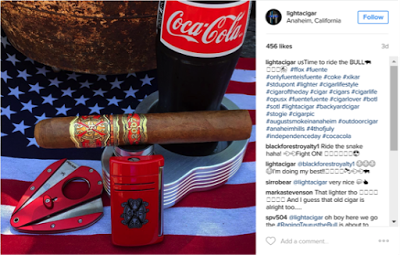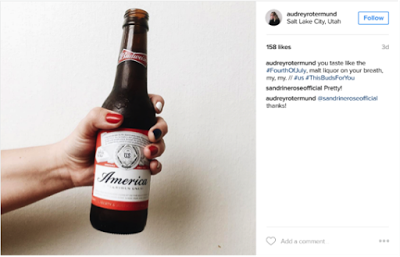Digital analytics
Image Recognition and the Future of Digital Analytics

This post was originally
published on Kelton Global's Blog.
published on Kelton Global's Blog.
The days of text-centric social feeds are officially long
gone. A whopping 1.8 billion images are uploaded to the Internet daily
and of those, 350 million are shared on Facebook. Instagram recently
surpassed 500 million active users, and Snapchat now has more active users than Twitter. The content that flows
into our social feeds is more heavily optimized than ever to deliver more of
what people want'less text and more visuals.
gone. A whopping 1.8 billion images are uploaded to the Internet daily
and of those, 350 million are shared on Facebook. Instagram recently
surpassed 500 million active users, and Snapchat now has more active users than Twitter. The content that flows
into our social feeds is more heavily optimized than ever to deliver more of
what people want'less text and more visuals.
Brands have adapted their social content strategies
accordingly by delivering more visually immersive experiences. And while we're
seeing significant shifts in branded content, this influx of visual content has
yet to herald a commensurate change in social analytics. Accordingly, few gains
have been made to measure and derive insights from the contents of images or
video. Social listening has historically focused on the challenges of text-based
analysis'specifically, the challenge of determining the context and meaning
behind posts. But as social media habits evolve, it's clear that deriving
insights from pictures is an increasingly important aspect of understanding
consumers. That's where image recognition comes into play.
accordingly by delivering more visually immersive experiences. And while we're
seeing significant shifts in branded content, this influx of visual content has
yet to herald a commensurate change in social analytics. Accordingly, few gains
have been made to measure and derive insights from the contents of images or
video. Social listening has historically focused on the challenges of text-based
analysis'specifically, the challenge of determining the context and meaning
behind posts. But as social media habits evolve, it's clear that deriving
insights from pictures is an increasingly important aspect of understanding
consumers. That's where image recognition comes into play.
Brands have adapted
their social content strategies accordingly by delivering more visually
immersive experiences.
their social content strategies accordingly by delivering more visually
immersive experiences.
Simply put, image recognition is the process of translating
images to data. Photos and images can reveal a wealth of data
points'demographics, purchases, personalities, and behaviors (just to name a
few). Through next generation image recognition, a mere selfie may reveal a
person's gender, approximate age, location disposition, and even the clothing
brands that the person is wearing. As text-centric media takes a backseat to
image and video, the opportunity to understand the contents of these formats
grows. These insights represent a veritable treasure trove of actionable data
for brands.
images to data. Photos and images can reveal a wealth of data
points'demographics, purchases, personalities, and behaviors (just to name a
few). Through next generation image recognition, a mere selfie may reveal a
person's gender, approximate age, location disposition, and even the clothing
brands that the person is wearing. As text-centric media takes a backseat to
image and video, the opportunity to understand the contents of these formats
grows. These insights represent a veritable treasure trove of actionable data
for brands.
Tools that analyze image and video-based content are still
in development, but increased investment in research is already impacting
commercial products and how they're advertised. One example is brand logo
recognition'scanning images for brand logos, and flagging them with the
corresponding brand names. This tool is especially powerful considering that 80% of photos shared online depict a brand logo but don't
explicitly call out the brand's name. This fact points to a sizable
opportunity for companies to measure and understand the impact of these formerly
inaccessible data points.
in development, but increased investment in research is already impacting
commercial products and how they're advertised. One example is brand logo
recognition'scanning images for brand logos, and flagging them with the
corresponding brand names. This tool is especially powerful considering that 80% of photos shared online depict a brand logo but don't
explicitly call out the brand's name. This fact points to a sizable
opportunity for companies to measure and understand the impact of these formerly
inaccessible data points.
Photos and images can
reveal a wealth of data points'demographics, purchases, personalities, and
behaviors (just to name a few).
reveal a wealth of data points'demographics, purchases, personalities, and
behaviors (just to name a few).
As an example of how this applies to brands, Kelton's
Digital Analytics team took a look at the scores of backyard BBQ photos that
flooded public forums, blogs, and social feeds over the recent 4th of July
holiday. We experimented to see which of two quintessentially American beverage
brands'Coca-Cola and Budweiser'netted more published images of
patriotically-themed bottles and cans (as well as other forms of branding) on
social media.
Digital Analytics team took a look at the scores of backyard BBQ photos that
flooded public forums, blogs, and social feeds over the recent 4th of July
holiday. We experimented to see which of two quintessentially American beverage
brands'Coca-Cola and Budweiser'netted more published images of
patriotically-themed bottles and cans (as well as other forms of branding) on
social media.
In the end, Coca-Cola branding was twice as prominent as
Budweiser's. We found that Coke bottles and cans popped up in more diverse
settings such as public parks and inside motor vehicles, whereas Budweiser was
predominantly found in bars and house parties. Coke also aroused greater
sentiment around the theme of Americana, as many consumers
photographed vintage Coca-Cola gear and opted for bottles over cans. This might
explain why Coke captured a significantly greater share of social mentions than
Budweiser.
Budweiser's. We found that Coke bottles and cans popped up in more diverse
settings such as public parks and inside motor vehicles, whereas Budweiser was
predominantly found in bars and house parties. Coke also aroused greater
sentiment around the theme of Americana, as many consumers
photographed vintage Coca-Cola gear and opted for bottles over cans. This might
explain why Coke captured a significantly greater share of social mentions than
Budweiser.
This example illustrates several ways that brands can
leverage image recognition technology to build actionable insights:
leverage image recognition technology to build actionable insights:
Ethnographic data ' Identify where, when
and how often brands are showing up in people's lives.
Updated brand health analysis ' We now have
a more comprehensive point of view of brands' online footprint.
Sponsorship and Branding ROI ' Extend the
value of branding and sponsorships shared via online news, blogs and social
media through a multiplier effect.
Influencer identification ' Find authentic
brand advocates who consume and spotlight your merchandise.
Misuse use of brand iconography ' Surface
content that depicts improper usage of brand's logo or other creative assets.
In today's ever-shifting social media landscape, it's never
been more important for brands and their partners to stay aware of the new and
emerging capabilities that can help better understand consumers' behavior
online. Image recognition is just the beginning. From AI startups to instant
objection recognition devices, the mobilization and fusion of research,
tech, and capital is quickly reshaping the way we think about analytics. These
new tools will add even more contextual understanding to sentiment on social
platforms, empowering brands to understand consumers like never before.
been more important for brands and their partners to stay aware of the new and
emerging capabilities that can help better understand consumers' behavior
online. Image recognition is just the beginning. From AI startups to instant
objection recognition devices, the mobilization and fusion of research,
tech, and capital is quickly reshaping the way we think about analytics. These
new tools will add even more contextual understanding to sentiment on social
platforms, empowering brands to understand consumers like never before.

